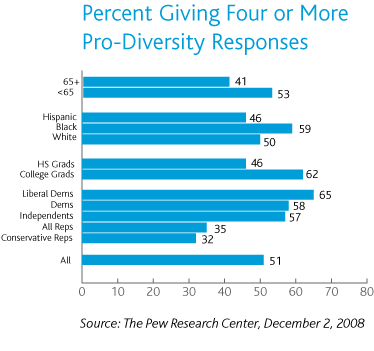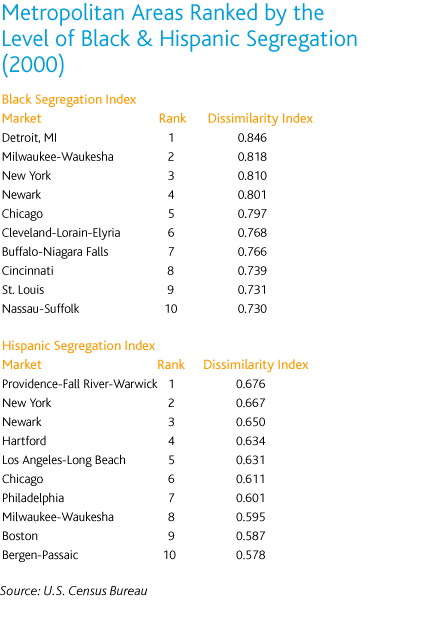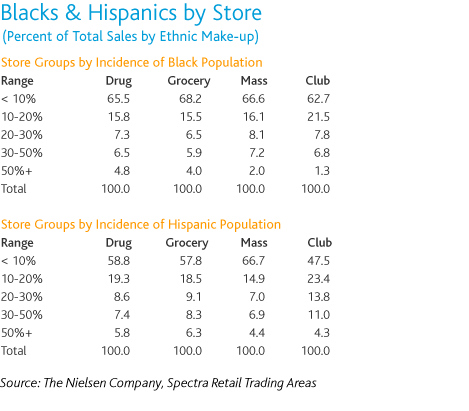Doug Anderson, EVP, Research & Development, The Nielsen Company
| SUMMARY: A new Pew Research Center survey suggests that most Americans value diversity and favor living in communities with a variety of income levels, political views and ethnic groups. Data from the U.S. Census Bureau and The Nielsen Company, however, paints a somewhat different picture, which shows that neighborhoods are still largely divided by race—and increasingly—by economics and politics. |
From almost any perspective, the United States is an incredibly varied and diverse country. There is tremendous range in climate, topography, affluence, degree of urbanization, ethnicity and household composition. According to results of a new survey from the Pew Research Center, released December 2008 (https://pewresearch.org), most Americans value diversity and favor living in communities with a variety of income levels, political views and ethnic groups. Data from the U.S. Census Bureau and The Nielsen Company, however, paints a somewhat different picture of how communities actually live—a portrait of a country still separated by race, ethnicity, political orientation and a wide range of other factors.
| This dichotomy between what consumers say and what they actually do poses a challenge to marketers… |
This dichotomy between what consumers say and what they actually do poses a challenge to marketers. While national advertising and promotion must reach and appeal to a wide range of consumers in a highly diverse marketplace, there is also a need for more locally-targeted advertising and promotion that speaks to the sentiments of varied consumer segments.
A preference for diversity
Seen in aggregate, the United States is an incredibly diverse country. The Ozzie and Harriet majority—the “American family ideal” of the 1950s and early 1960s—has fragmented into countless unique subgroups. In the early 1960s, nearly half of all U.S. households had children under 18, and the majority of those households contained married couples where only the husband worked outside the home. Today, there are more single parent with children households than there are the former “traditional” families. The plurality of family households has both parents working, but only account for 41% of total. Over 70% of women with children work outside the home.
| Within 16 years, a higher share of the U.S. population will be foreign born… |
The racial and ethnic makeup of the U.S. has been used to define the concept of diversity. Tremendous growth among Hispanics and Asians has changed the ethnic face of the country over the past several decades, and will continue to change it for decades to come. Hispanics make up 15% of the U.S. population today, a level expected to double by 2050. With continuing high levels of immigration, within 16 years, a higher share of the U.S. population will be foreign born than during the prior peak immigration years early in the 20th century.
The Pew survey asked Americans if they like diversity in their communities and found overall that they do. Just over half (51%) of Americans gave pro-diversity responses to at least four of the five survey areas (political, racial, religious, socioeconomic and immigrants). There was however, considerable variation based on political party affiliation, education, race and age as can be seen in the chart below.

Results from the study also revealed that:
- 65% prefer to live in a community with a mixed racial make-up
- 73% of Democrats versus 52% of Republicans
- 76% of those ages 18-29 versus 47% of those ages 65+
- 83% of blacks, 69% of Hispanics, 60% of non-Hispanic white
- 59% prefer to live in a community with many different religious groups
- 73% of liberal Democrats versus 44% of conservative Republicans
- 70% of college graduates versus 52% of those with high school education or less
- 61% prefer to live in a community with a mix of upper, middle, and lower classes
- 71% of liberal Democrats versus 57% of all Republicans
- 68% of those with $100k+ in household income versus 55% of those with household income of
| Most Americans live in neighborhoods that are much more likely not to have such mixes… |
Local areas are not so varied
In spite of the surveyed preferences for varied communities—those with a mix of races, religions, and incomes— most Americans live in neighborhoods that are much more likely not to have such mixes. Using the latest small area data from Nielsen, it is possible to see how concentrated various ethnic and/or racial groups are in the U.S. Although there is significantly more racial integration at the community and neighborhood levels than there was in 1950 and 1960, by and large the U.S. remains a country separated by race and ethnicity. In 1990, the most concentrated 50% of Hispanics lived in neighborhoods that were at least 48% Hispanic. By 2000, the most concentrated 50% lived in neighborhoods that were at least 51% Hispanic, meaning that Hispanics were more concentrated geographically in 2000 than in 1990. Much of this can be attributed to the rapid growth in the Hispanic population between 1990 and 2000, driven by immigration with many new immigrants moving into Hispanic-dominant neighborhoods.
Blacks also live in very concentrated communities. The most concentrated 25% of black households resides in neighborhoods that are at least 77% black. The top half live in areas that are at least 43% black. Over one-third of non-Hispanic white households live in Census tracts in which less than one out of each 100 residents on average are black. Nearly 70% of non-Hispanic white households live in tracts that are less than 5% black.
Asians do not live in neighborhoods nearly as ethnically concentrated as blacks and Hispanics, though this varies substantially by country of origin. For example, Japanese immigrants and Americans of Japanese origin are much less concentrated than those from China or India. These differences in geographic concentration are strongly associated with education (and consequently with affluence). College educated ethnic Americans are much less likely to live in dominant ethnic neighborhoods than those with high school educations or less.
Data from the U.S Census Bureau in the table below shows the most segregated metropolitan areas in the U.S. for both blacks and Hispanics. The markets are ranked by a Dissimilarity Index. The index measures the percentage of a group’s population that would have to change neighborhoods for all neighborhoods to have the same incidence of the group as in the market as a whole. For example, 85% of the blacks in Detroit would need to move to white-dominated neighborhoods in order for every neighborhood in Detroit to have the same incidence of blacks.

Income is a differentiator
There is also substantial and growing separation of households by income in the U.S. Prior to World War II, many more Americans lived in smaller towns and cities with a mix of income levels, where factory owners and factory workers; doctors and patients; and store owners and customers lived in the same communities. With the rapid suburbanization of American after the war and the related increase in poverty in cities, households of differing income levels tended to separate.
An article in the journal Demography by Fischer, Stockmayer, Stiles, and Hout (volume 41, pages 37-59) finds that between 1970 and 2000 there was a 32% increase in the separation of higher income Americans (the top 20%) from all other Americans. Despite this trend toward the geographic isolation of higher income households—which continues today—blacks and Hispanics are still nearly three times as separated from non-Hispanic whites as affluent Americans are from the bottom 80%.
Local targeting at the store level
With such broad diversity and concentration of population groups at the local level, locally-targeted advertising and promotion become even more important. Like communities, stores are also very well defined by their makeup along racial, ethnic, or affluence lines, and as such are very targetable. The Nielsen data in the table below summarizes the distribution of sales for the major retail channels based on the distribution of blacks and Hispanics in the individual store’s trading areas.

| Communities have become more politically homogenous rather than less… |
Politics and diversity
In the Pew Survey, 63% of respondents said they would prefer to live in a community made up of people with a mix of political views, while less than one-quarter prefer to live in a place where everyone shared their own political views. Political diversity was most valued by Independents (i.e., not Democrats or Republicans), by blacks, and by those with incomes over $100,000. However, over the last 35 years, based on analysis of election returns, communities have become more politically homogenous rather than less. In their book, “The Big Sort”, which argues that Americans are clustering into politically similar communities, Bishop and Cushing show this trend toward politically homogenous communities using the latest election data.
In the 2008 presidential election, nearly half of all votes were cast in counties that went for a candidate by 20 or more percentage points. In 1976, when Carter defeated Ford, only 27% of voters lived in counties where the margin was more than 20 percentage points. It seems less likely that individuals have made conscious decisions to move into communities based on political trends, but rather that demographics account for much of the difference. Political affiliation is generally tied to certain key demographics that govern decisions about where to live; income and home values, presence or absence of families with children, education, racial or ethnic make-up all influence where people choose to live and also influence political affiliation.
Theory versus reality catching up
The Pew survey results suggest that Americans are accepting of diversity, even if communities haven’t quite caught up yet. Demographic projections reveal quite clearly that the U.S. will become even more diverse over the decades to come, as the majority of population growth will come from new immigrants entering the country. Seen from the top down, the U.S. is still the melting pot of the world—a nation that is diverse ethnically, politically, economically, and in its beliefs.
From the bottom up, however, neighborhoods are still largely divided by race—and increasingly—by economics and politics. Marketers need to find a common ground for their products, varying the scope of advertising and promotional messages by national, regional or local delivery. Accurate targeting, driven by data to keep up with an ever changing country, will be necessary not only to drive growth, but simply to maintain balance.
Sources:
The Nielsen Company, Claritas & Spectra
Pew Research Center – Americans Say They Like Diverse Communities; Election, Census Trends Suggest Otherwise (released December 2, 2008)



